Stone Paper as a New Substrate to Fabricate Flexible Screen-Printed Electrodes for the Electrochemical Detection of Dopamine
Abstract
1. Introduction
2. Materials and Methods
2.1. Chemical and Reagents
2.2. Apparatus
2.3. Fabrication of Flexible Screen-Printed Electrodes on Stone Paper Substrate
3. Results and Discussion
3.1. Morphological Characterization of the Flexible Screen-Printed Electrodes (HP and HP-AuNPs)
3.2. Electrochemical Characterization of the Flexible Screen-Printed Electrodes (HP and HP-AuNPs)
3.3. Electrochemical Detection of Dopamine (DA) with HP and HP-AuNPs Flexible Electrodes
4. Conclusions
Supplementary Materials
Author Contributions
Funding
Acknowledgments
Conflicts of Interest
References
- Feig, V.R.; Tran, H.; Bao, Z. Biodegradable Polymeric Materials in Degradable Electronic Devices. ACS Cent. Sci. 2018, 4, 337–348. [Google Scholar] [CrossRef] [PubMed]
- Chen, X.; Ahn, J.H. Biodegradable and bioabsorbable sensors based on two-dimensional materials. J. Mater. Chem. B 2020, 8, 1082–1092. [Google Scholar] [CrossRef] [PubMed]
- Moro, G.; Bottari, F.; Van Loon, J.; Du Bois, E.; De Wael, K.; Moretto, L.M. Disposable electrodes from waste materials and renewable sources for (bio)electroanalytical applications. Biosens. Bioelectron. 2019, 146, 111758. [Google Scholar] [CrossRef] [PubMed]
- Singh, A.T.; Lantigua, D.; Meka, A.; Taing, S.; Pandher, M.; Camci-Unal, G. Paper-based sensors: Emerging themes and applications. Sensors 2018, 18, 2838. [Google Scholar] [CrossRef]
- Noviana, E.; McCord, C.P.; Clark, K.M.; Jang, I.; Henry, C.S. Electrochemical paper-based devices: Sensing approaches and progress toward practical applications. Lab Chip 2019, 20, 9–34. [Google Scholar] [CrossRef]
- He, J.; Luo, M.; Hu, L.; Zhou, Y.; Jiang, S.; Song, H.; Ye, R.; Chen, J.; Gao, L.; Tang, J. Flexible lead sulfide colloidal quantum dot photodetector using pencil graphite electrodes on paper substrates. J. Alloys Compd. 2014, 596, 73–78. [Google Scholar] [CrossRef]
- Chu, C.; Nel, P. Characterisation and deterioration of stone papers. AICCM Bull. 2019, 40, 37–49. [Google Scholar] [CrossRef]
- Roeleveld, P.P.; de Klerk, J.C.A. The Perspective of the Intensivist on Inotropes and Postoperative Care Following Pediatric Heart Surgery: An International Survey and Systematic Review of the Literature. World J. Pediatr. Congenit. Heart Surg. 2018, 9, 10–21. [Google Scholar] [CrossRef]
- Ji, D.; Liu, Z.; Liu, L.; Low, S.S.; Lu, Y.; Yu, X.; Zhu, L.; Li, C.; Liu, Q. Smartphone-based integrated voltammetry system for simultaneous detection of ascorbic acid, dopamine, and uric acid with graphene and gold nanoparticles modified screen-printed electrodes. Biosens. Bioelectron. 2018, 119, 55–62. [Google Scholar] [CrossRef]
- Zhang, Y.; Li, B.; Chen, X. Simple and sensitive detection of dopamine in the presence of high concentration of ascorbic acid using gold nanoparticles as colorimetric probes. Microchim. Acta. 2010, 168, 107–113. [Google Scholar] [CrossRef]
- Liu, X.; Tian, M.; Gao, W.; Zhao, J. A Simple, Rapid, Fluorometric Assay for Dopamine by in Situ Reaction of Boronic Acids and cis -Diol. J. Anal. Methods Chem. 2019, 2019. [Google Scholar] [CrossRef] [PubMed]
- De Benedetto, G.E.; Fico, D.; Pennetta, A.; Malitesta, C.; Nicolardi, G.; Lofrumento, D.D.; De Nuccio, F.; La Pesa, V. A rapid and simple method for the determination of 3,4-dihydroxyphenylacetic acid, norepinephrine, dopamine, and serotonin in mouse brain homogenate by HPLC with fluorimetric detection. J. Pharm. Biomed. Anal. 2014, 98, 266–270. [Google Scholar] [CrossRef] [PubMed]
- Uutela, P.; Karhu, L.; Piepponen, P.; Käenmäki, M.; Ketola, R.A.; Kostiainen, R. Discovery of dopamine glucuronide in rat and mouse brain microdialysis samples using liquid chromatography tandem mass spectrometry. Anal. Chem. 2009, 81, 427–434. [Google Scholar] [CrossRef] [PubMed]
- Azzouz, A.; Goud, K.Y.; Raza, N.; Ballesteros, E.; Lee, S.E.; Hong, J.; Deep, A.; Kim, K.H. Nanomaterial-based electrochemical sensors for the detection of neurochemicals in biological matrices. TrAC Trends Anal. Chem. 2019, 110, 15–34. [Google Scholar] [CrossRef]
- Eddin, F.B.K.; Fen, Y.W. Recent advances in electrochemical and optical sensing of dopamine. Sensors 2020, 20, 1039. [Google Scholar] [CrossRef]
- Cai, W.; Lai, T.; Du, H.; Ye, J. Electrochemical determination of ascorbic acid, dopamine and uric acid based on an exfoliated graphite paper electrode: A high performance flexible sensor. Sens. Actuators B Chem. 2014, 193, 492–500. [Google Scholar] [CrossRef]
- Moreno, M.; Arribas, A.S.; Bermejo, E.; Chicharro, M.; Zapardiel, A.; Rodríguez, M.C.; Jalit, Y.; Rivas, G.A. Selective detection of dopamine in the presence of ascorbic acid using carbon nanotube modified screen-printed electrodes. Talanta 2010, 80, 2149–2156. [Google Scholar] [CrossRef]
- Manbohi, A.; Ahmadi, S.H. Sensitive and selective detection of dopamine using electrochemical microfluidic paper-based analytical nanosensor. Sens. Bio-Sens. Res. 2019, 23, 100270. [Google Scholar] [CrossRef]
- Gupta, P.; Goyal, R.N.; Shim, Y.B. Simultaneous analysis of dopamine and 5-hydroxyindoleacetic acid at nanogold modified screen printed carbon electrodes. Sens. Actuators B Chem. 2015, 213, 72–81. [Google Scholar] [CrossRef]
- Pradela-Filho, L.A.; Araújo, D.A.G.; Takeuchi, R.M.; Santos, A.L. Nail polish and carbon powder: An attractive mixture to prepare paper-based electrodes. Electrochim. Acta 2017, 258, 786–792. [Google Scholar] [CrossRef]
- Liu, X.; Xi, X.; Chen, C.; Liu, F.; Wu, D.; Wang, L.; Ji, W.; Su, Y.; Liu, R. Ordered mesoporous carbon-covered carbonized silk fabrics for flexible electrochemical dopamine detection. J. Mater. Chem. B 2019, 7, 2145–2150. [Google Scholar] [CrossRef] [PubMed]
- Gerischer, H. Modern Aspects of Electrochemistry. Zeitschrift Für Phys. Chemie. 2011, 29, 287–288. [Google Scholar] [CrossRef]
- Ferrari, A.G.M.; Foster, C.W.; Kelly, P.J.; Brownson, D.A.C.; Banks, C.E. Determination of the electrochemical area of screen-printed electrochemical sensing platforms. Biosensors 2018, 8, 1–10. [Google Scholar]
- Bard, A.J.; Faulkner, L.R. Electrochemical methods: Fundamentals and Applications, 2nd ed.; John Wiley & Sons, Inc.: Hoboken, NJ, USA, 2001. [Google Scholar]
- Prathish, K.P.; Barsan, M.M.; Geng, D.; Sun, X.; Brett, C.M.A. Chemically modified graphene and nitrogen-doped graphene: Electrochemical characterisation and sensing applications. Electrochim. Acta 2013, 114, 533–542. [Google Scholar] [CrossRef]
- Nkosi, D.; Pillay, J.; Ozoemena, K.I.; Nouneh, K.; Oyama, M. Heterogeneous electron transfer kinetics and electrocatalytic behaviour of mixed self-assembled ferrocenes and SWCNT layers. Phys. Chem. Chem. Phys. 2010, 12, 604–613. [Google Scholar] [CrossRef]
- Ibáñez-Redín, G.; Wilson, D.; Gonçalves, D.; Oliveira, O.N. Low-cost screen-printed electrodes based on electrochemically reduced graphene oxide-carbon black nanocomposites for dopamine, epinephrine and paracetamol detection. J. Colloid Interface Sci. 2018, 515, 101–108. [Google Scholar] [CrossRef]
- Hui, X.; Xuan, X.; Kim, J.; Park, J.Y. A highly flexible and selective dopamine sensor based on Pt-Au nanoparticle-modified laser-induced graphene. Electrochim. Acta. 2019, 328, 135066. [Google Scholar] [CrossRef]
- Li, J.; Yang, J.; Yang, Z.; Li, Y.; Yu, S.; Xu, Q.; Hu, X. Graphene-Au nanoparticles nanocomposite film for selective electrochemical determination of dopamine. Anal. Methods 2012, 4, 1725–1728. [Google Scholar] [CrossRef]
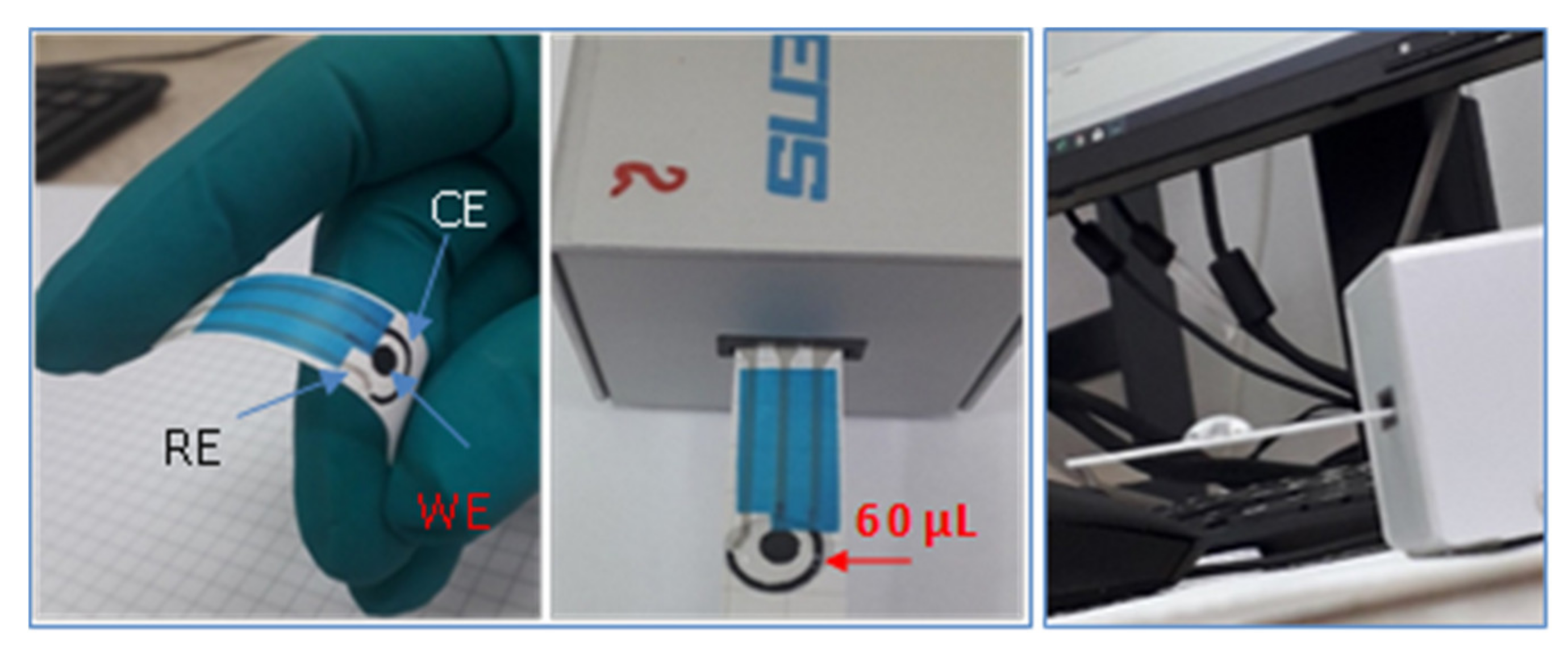
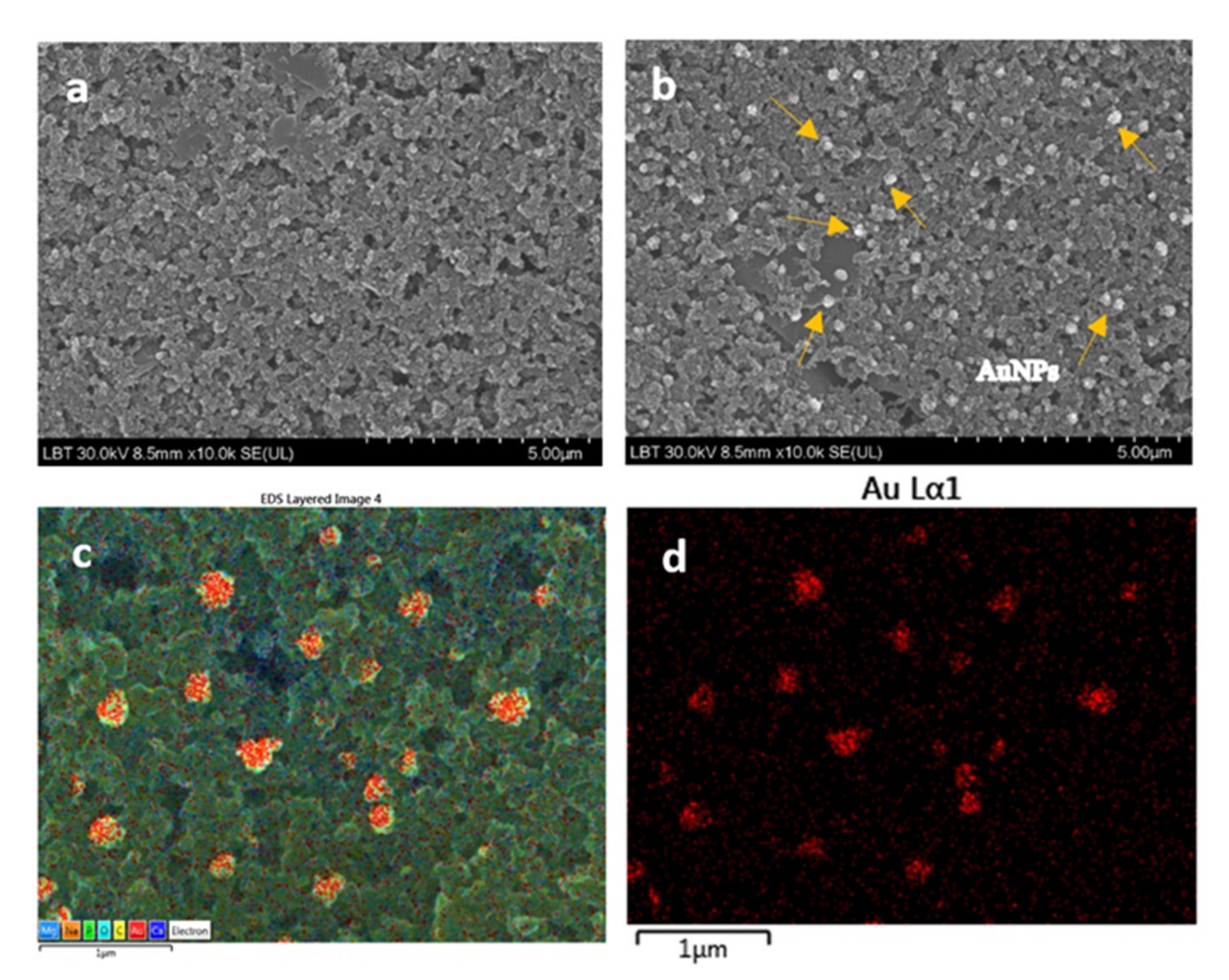
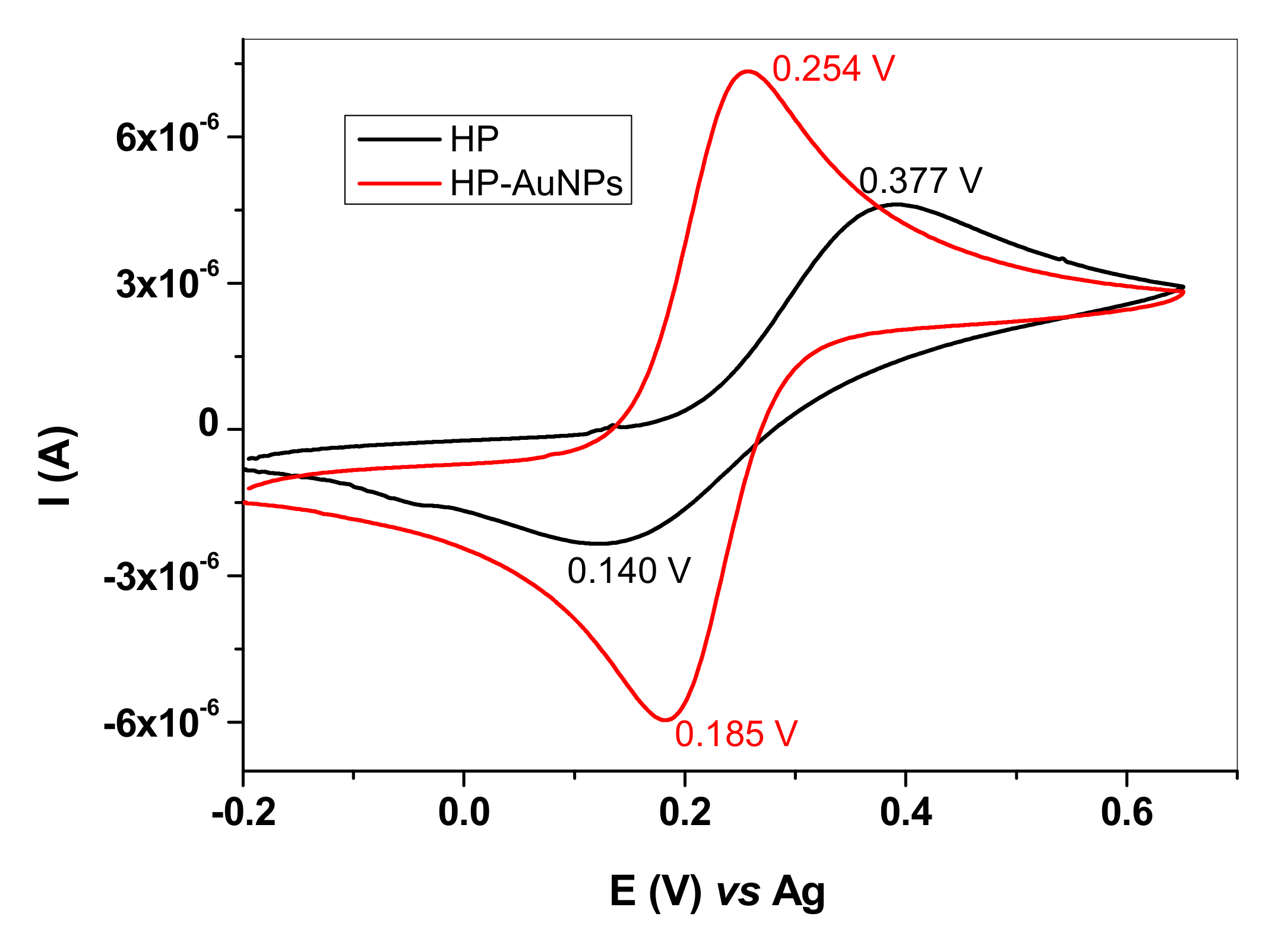

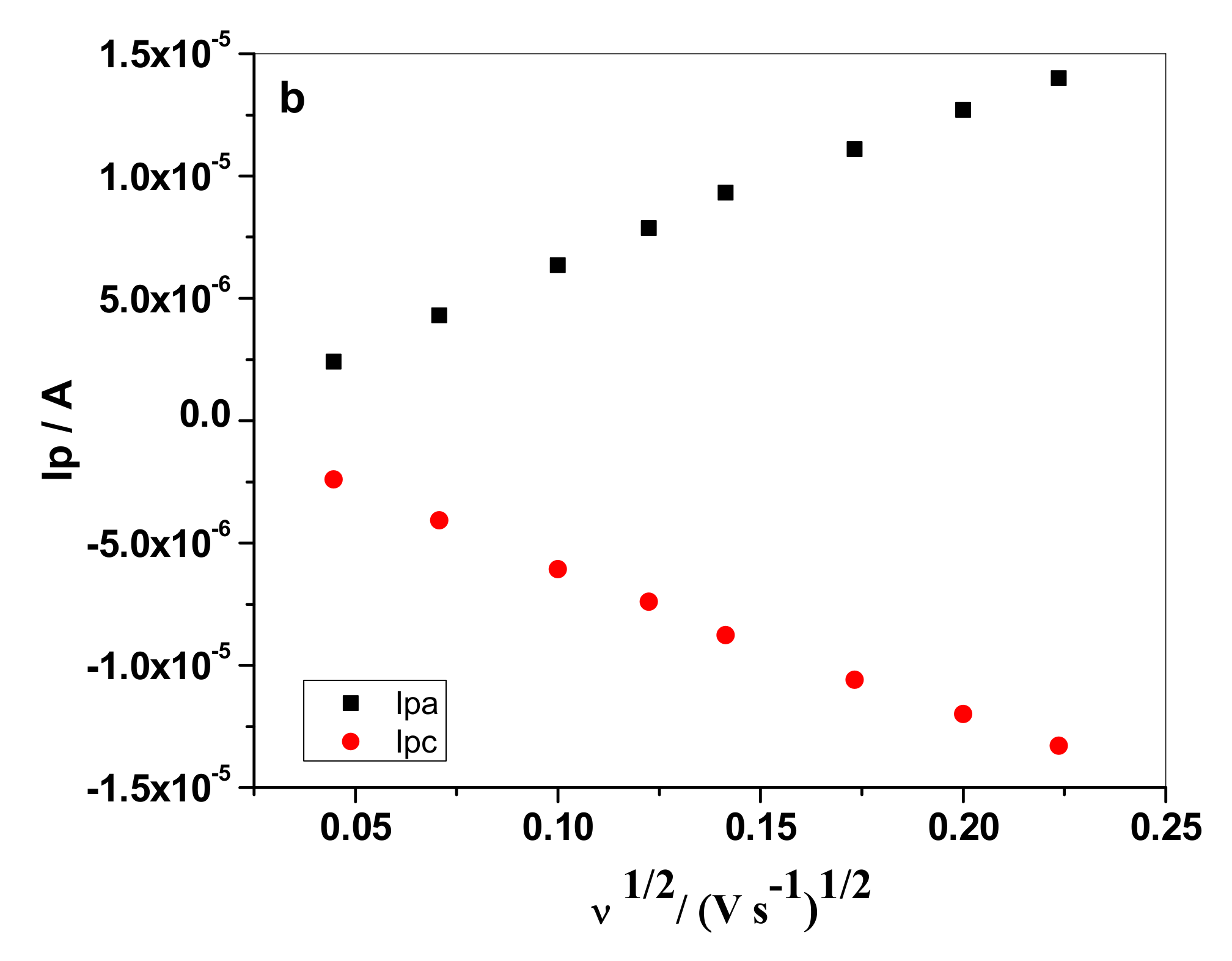
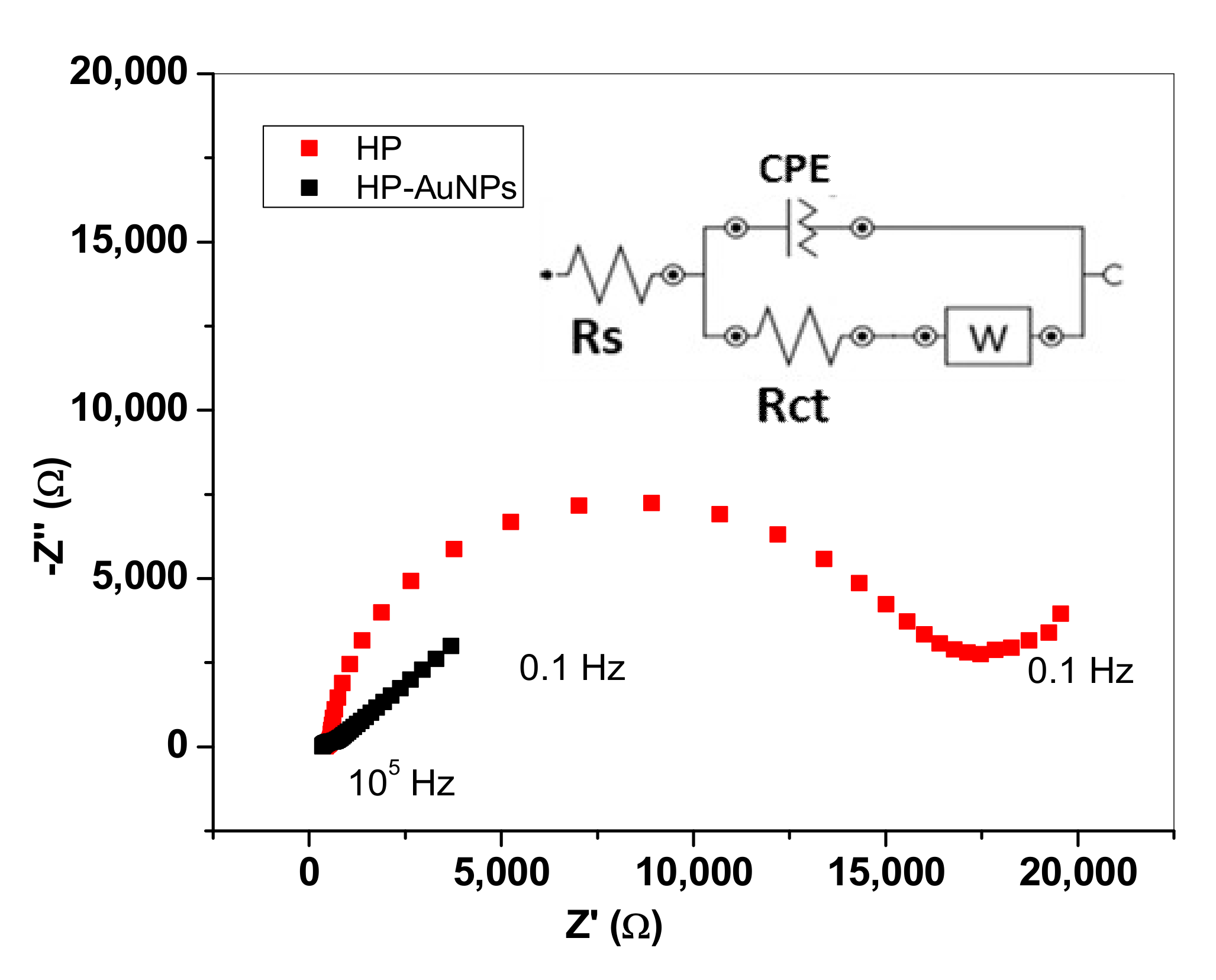
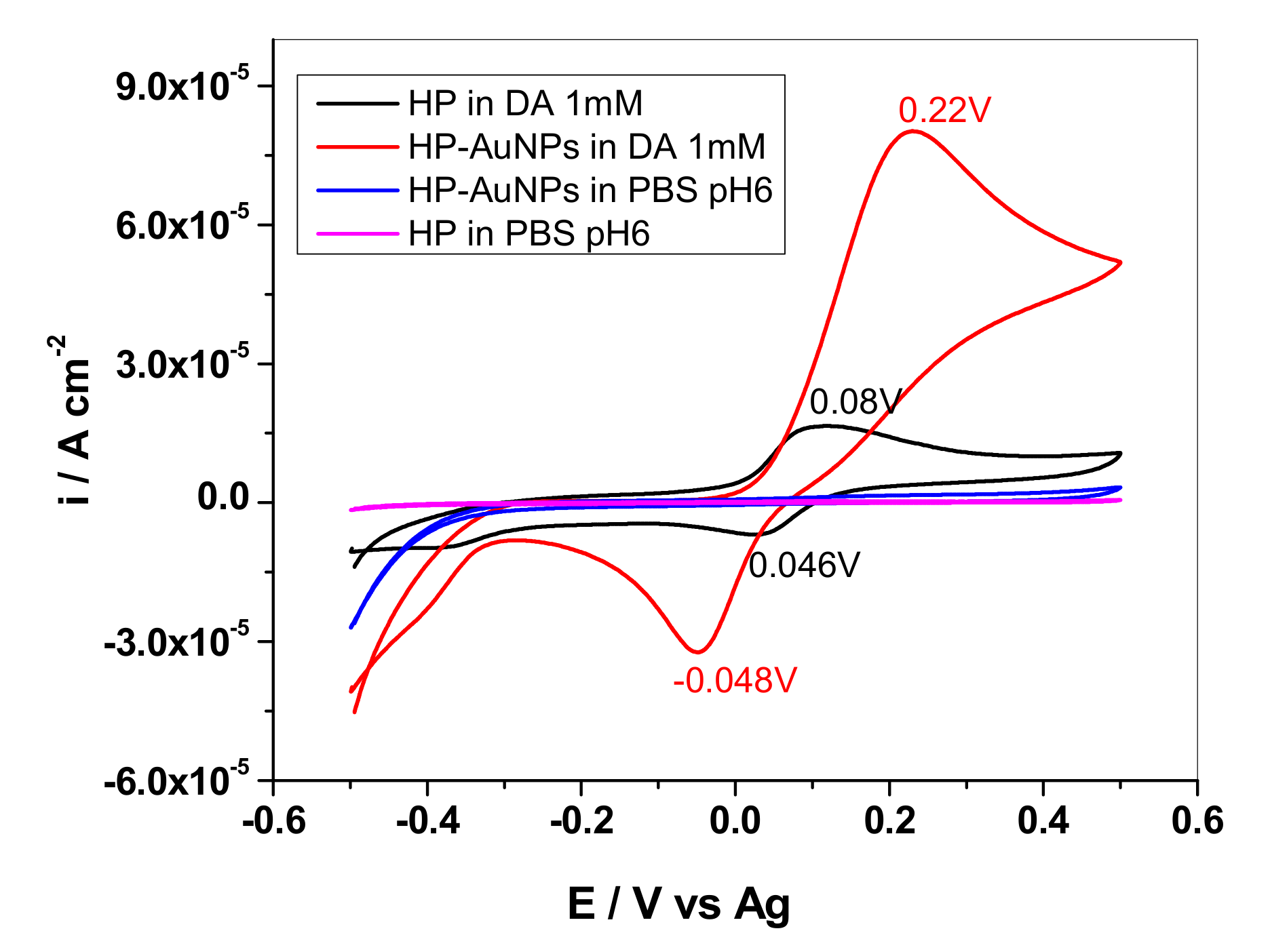



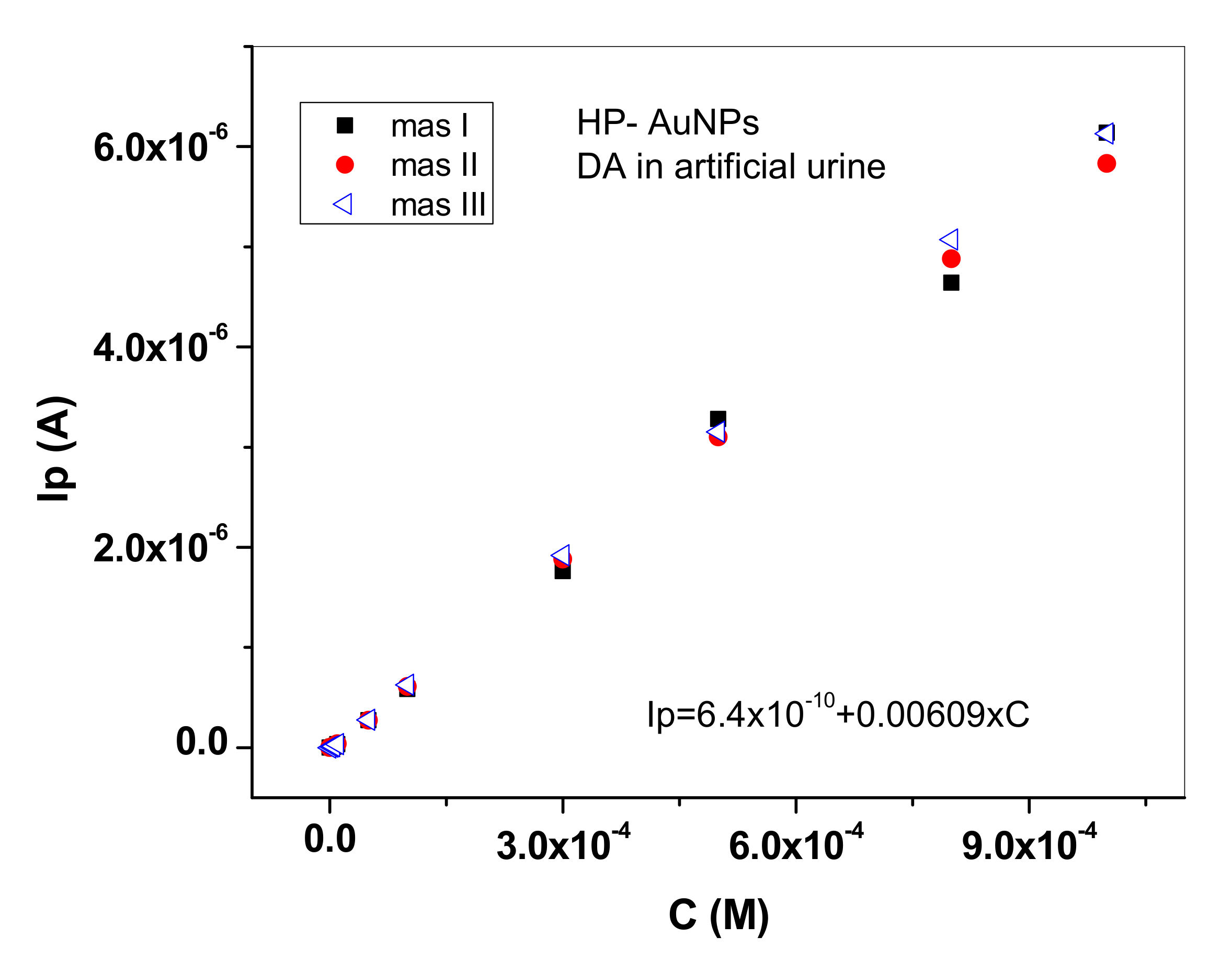
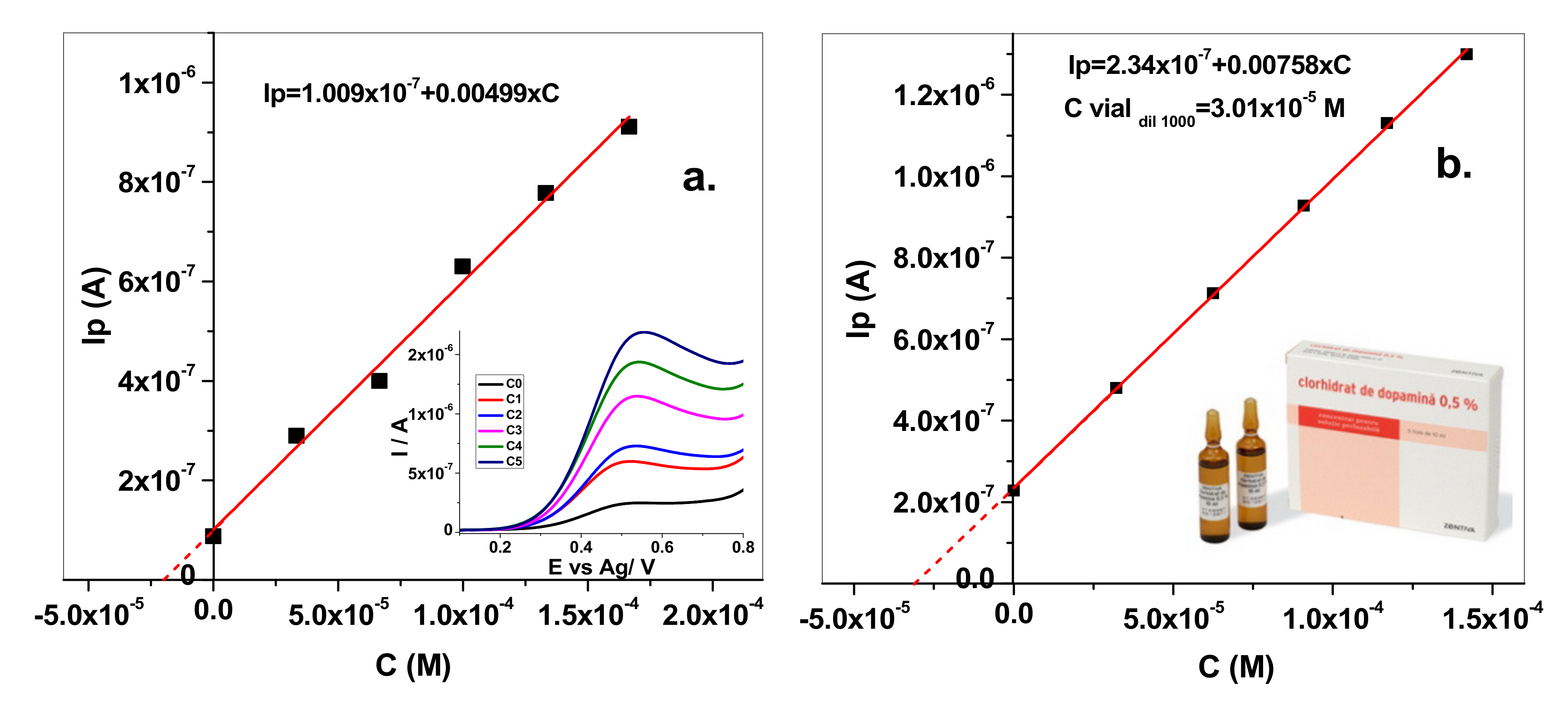
| Electrode | ΔEp (mV) | Ipa/Ipc | A (cm2) | E0′ (V) | Rct (Ω) | Kapp (cm/s) |
|---|---|---|---|---|---|---|
| HP | 237 | 1.3 | 0.06 | 0.265 | 15,700 | 2.8 × 10−4 |
| HP-AuNPs | 69 | 1.0 | 0.112 | 0.220 | 1220 | 1.94 × 10−3 |
| Electrode | Substrate | Technique | LOD (µM) | Linear Domain (M) | Ref. |
|---|---|---|---|---|---|
| HP | Stone paper | LSV | 0.3 | 10−6–10−3 | This work |
| HP-AuNPs | Stone paper | LSV | 0.03 | 10−7–10−3 | This work |
| SPCE | PET | SWV | 0.73 | 5 × 10−6–10−5 | [1] |
| e-FGPE | graphite paper | DPV | 0.01 | 0.5 × 10−6–35 × 10−6 | [16] |
| SPE-MWCNT | ceramic | DPV | 0.015 | 5·× 10−8–10−6 | [17] |
| AuNPs-SPC | Polystyrene based film | SWV | 0.008 | 2·× 10−7–10−4 | [19] |
| SPCE/CB-ERGO | PET | SWV | 0.41 | 10−6–10−5 | [27] |
| Pt-AuNPs/LIG/PDMS | PDMS | DPV | 0.075 | 9.5 × 10−7–3 × 10−5 | [28] |
| Graphene/AuNP/GCE | GCE | DPV | 1.86 | 5 × 10−6–10−3 | [29] |
| Solution | Added (M) | Found (M) | Recovery (%) | RSD (%) |
|---|---|---|---|---|
| Artificial urine | 2 × 10−5 | 2.02 × 10−5 | 101 | 3.5 |
| Pharmaceutical drug solution | 2.63 × 10−5 | 3.01 × 10−5 | 114 | 6.5 |
© 2020 by the authors. Licensee MDPI, Basel, Switzerland. This article is an open access article distributed under the terms and conditions of the Creative Commons Attribution (CC BY) license (http://creativecommons.org/licenses/by/4.0/).
Share and Cite
Varodi, C.; Pogacean, F.; Gheorghe, M.; Mirel, V.; Coros, M.; Barbu-Tudoran, L.; Stefan-van Staden, R.-I.; Pruneanu, S. Stone Paper as a New Substrate to Fabricate Flexible Screen-Printed Electrodes for the Electrochemical Detection of Dopamine. Sensors 2020, 20, 3609. https://doi.org/10.3390/s20123609
Varodi C, Pogacean F, Gheorghe M, Mirel V, Coros M, Barbu-Tudoran L, Stefan-van Staden R-I, Pruneanu S. Stone Paper as a New Substrate to Fabricate Flexible Screen-Printed Electrodes for the Electrochemical Detection of Dopamine. Sensors. 2020; 20(12):3609. https://doi.org/10.3390/s20123609
Chicago/Turabian StyleVarodi, Codruta, Florina Pogacean, Marin Gheorghe, Valentin Mirel, Maria Coros, Lucian Barbu-Tudoran, Raluca-Ioana Stefan-van Staden, and Stela Pruneanu. 2020. "Stone Paper as a New Substrate to Fabricate Flexible Screen-Printed Electrodes for the Electrochemical Detection of Dopamine" Sensors 20, no. 12: 3609. https://doi.org/10.3390/s20123609
APA StyleVarodi, C., Pogacean, F., Gheorghe, M., Mirel, V., Coros, M., Barbu-Tudoran, L., Stefan-van Staden, R.-I., & Pruneanu, S. (2020). Stone Paper as a New Substrate to Fabricate Flexible Screen-Printed Electrodes for the Electrochemical Detection of Dopamine. Sensors, 20(12), 3609. https://doi.org/10.3390/s20123609







